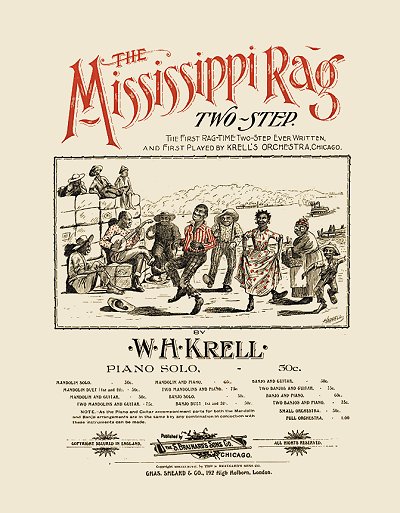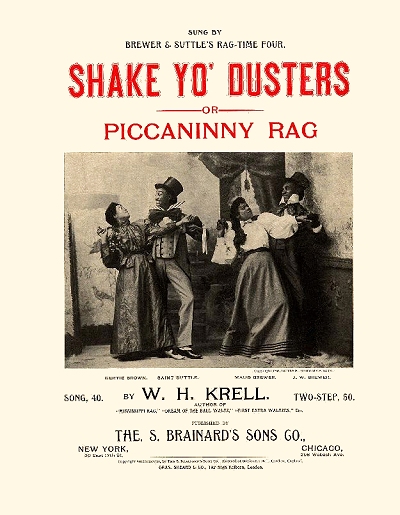 William Henry Krell (May, 1868 to September 30, 1933) | |
 Compositions Compositions | |
|
1893
Our Carter: A Beautiful Ballad [1]1895
The Cake Walk Patrol: Two-StepThe First Extra: Waltzes Strolling on the Beach A Dream of the Ball (Waltzes) The Time He Loves The Best [2] 1896
Arbutus: WaltzThe Recreation 1897
The Mississippi Rag: Two-StepSummer Girl Waltzes Finnigan Cadets: Two-Step |
1898
Shake Yo' Dusters: Rag-Time FourShake Yo' Dusters (Song) The American Girl Battle Ship March Fighting Bob Evans: March and Two-Step 1899
Cyrano1900
The Bowery Spielers1901
The Senator
1. w/Silas Leachman
2. w/L.H. Freeman |
Not much has been written about William H. Krell beyond his significant role as the second white composer to have a piece published with the word "rag" in the title, (Theodore Northrup's Louisiana Rag is regarded as the first such piece). That he did is happenstance, but it did not make him so famous until nearly two decades after his death. As a result, there is little in the way of biographical information available on Krell, but at least a general narrative has been pieced together from what records and notices were located, as well as some input from a family member.
but at least a general narrative has been pieced together from what records and notices were located, as well as some input from a family member.
 but at least a general narrative has been pieced together from what records and notices were located, as well as some input from a family member.
but at least a general narrative has been pieced together from what records and notices were located, as well as some input from a family member.In spite of common sources dating back to They All Played Ragtime citing an 1873 birth date, Krell was actually born in May of 1868 in Tamaqua, Pennsylvania, to cigar maker German immigrants Frederick Gottfried Krell and his Pennsylvania born wife Wilhelmine Susan Krell, who was possibly Frederick's distant cousin. In the 1870 enumeration the couple was shown residing with his parents and 9 year old brother Henry (1861), as well as William's infant brother Frederick (1870). Susan Krell passed on in 1872. In 1873, father was married again, this time to German immigrant Mary Magdalena "Lena" Kull and by 1880, Frederick had one other younger sibling, half-sister Amelia (1877). His half-brother Albert C. was born in December of 1880.
Young William learned brass instruments and some piano in secondary school, and eventually received enough musical training to become a bandleader and arranger. Pennsylvania was known for its many industrially-sponsored bands put together by mines, factories, fire brigades, etc., so there were plenty of opportunities for Will to get involved. He moved to Chicago, Illinois sometime between 1888 and 1890. It was there that William met and married Jeannette Krell of Wisconsin in 1890. It was her second marriage, and she brought her song along with her, but Harvey (8/1884) would take his stepfather's name. William was seen on Chicago voter registration records starting around the time of their marriage.
By the early 1890s William was getting work playing in or conducting bands, including some touring organizations. His earliest publications were waltzes and ballads, one of them dedicated to the late Chicago Mayor Carter Harrison who had died two days short of of the closing of the 1893 World's Columbian Exhibition. Krell is also credited with getting one of the earliest cakewalks in print, The Cake Walk Patrol. The typical patrol represented the point of view of a parade observer as they heard a band march by, starting softly in the distance, growing to a crescendo as they walked by and played their more dynamic themes, and then ending as it began with the band marching off into the distance. The most famous piece of this king at that time was American Patrol by F.W. Meachem, still popular more than a century after it was introduced. Notices for Krell's orchestra playing patrols and cakewalks started appearing in early 1896.
growing to a crescendo as they walked by and played their more dynamic themes, and then ending as it began with the band marching off into the distance. The most famous piece of this king at that time was American Patrol by F.W. Meachem, still popular more than a century after it was introduced. Notices for Krell's orchestra playing patrols and cakewalks started appearing in early 1896.
 growing to a crescendo as they walked by and played their more dynamic themes, and then ending as it began with the band marching off into the distance. The most famous piece of this king at that time was American Patrol by F.W. Meachem, still popular more than a century after it was introduced. Notices for Krell's orchestra playing patrols and cakewalks started appearing in early 1896.
growing to a crescendo as they walked by and played their more dynamic themes, and then ending as it began with the band marching off into the distance. The most famous piece of this king at that time was American Patrol by F.W. Meachem, still popular more than a century after it was introduced. Notices for Krell's orchestra playing patrols and cakewalks started appearing in early 1896.While on tour in the American South in late 1896, William and his group were exposed to many local musicians playing advanced cakewalk strains that they called rag or ragtime. Upon his return to Chicago, his publisher, S. Brainard's Sons Company, was holding a contest with a cash prize for the best ragtime composition that could be submitted. Krell had formulated some of what he heard on the tour into a band number for his group that they had already been playing when the prize was announced. He transcribed a reduction of it into a piano score and submitted what became the winning entry, The Mississippi Rag, copyrighted on January 27, 1897. While actually another cakewalk patrol piece (starts softly, builds to the middle, fades and ends as it began), the word "Rag" in the title gave it historical significance. Note that it is not the first true "rag" (perhaps Theodore Northrup's Louisiana [Pas-ma-la] fits that title), but its popularity helped spur an onslaught of rag pieces over the next few months that ultimately lasted for nearly two decades. Shortly after Mississippi Rag was in print, Tom Turpin became the first black composer to publish a real piano rag, his Harlem Rag, in St. Louis.
Krell scored again the following year with Shake Yo' Dusters, which was closer to true ragtime in construction, but never quite recaptured the spirit of his first rag contribution, and composed virtually nothing after that for the piano. He spent most of his time leading his orchestra, both for society events and in limited engagements at entertainment venues. They were in an extremely competitive mode at that time as the field was getting crowded. This was underscored by a tiff he had that made the news in the Chicago Daily Tribune on September 22. 1900:
Differences between William H. Krell… proprietor of the Krell Orchestra, and Harry Diamond, the "boy wonder" violinist, culminated in open discord in the rooms of the Chicago Musical Society at 83 Madison street yesterday afternoon. Krell struck Diamond, knocking him across a room, because, he declared, Diamond has called him a "short skate."
The quarrel started over competition in business. Krell played during the summer at the Heidelberg Gardens on Fifty-first street, but since the close of the garden he has been seeking engagements for this orchestra at private entertainments. Diamond also endeavored to procure engagements for an orchestra which he is organizing. He formerly had worked for Krell, his discharge leading to a feud between the two musicians. Diamond then began competing with his former employer. Although he is 20 years old, he is known in musical circles as the "boy wonder."
Krell says when he met Diamond in the Chicago Musical Society rooms the latter was making remarks concerning the business methods of the Krell Orchestra. Krell's interference led to the quarrel. Diamond, who was badly injured, threatened to get out a warrant for the arrest of Krell.
"Diamond has persisted in attacking me, " said Mr. Krell. "He has been envious of my business and has attempted to injure it. I tolerated a great deal from him, but when he called me a 'short skate' I felt fully justified in striking him. I don't think he would dare to have me arrested." Diamond could not be found last night."

Krell was shown as living and working in Chicago from the mid-1890s through at least the mid-1910s, listed in both the 1900 and 1910 census records as a musician. Some city directories listed him as either a musician or conductor. In the 1900 census his brother Fred was shown as living with the couple and also working as a musician. By 1910, his stepson Harvey had likely died as Jeannette was shown to have had one child but none surviving, and he cannot be found in any subsequent records.
Notices of regular engagements of Krell's Band and Krell's Orchestra were seen in Chicago newspapers as late as 1914. His lead violinist, John Cerny, left the group in late 1913, advertising that he was forming his own orchestra, and was looking for patronage. This may have been a harbinger of the slow dismantling of the Krell groups. The band notices in the 1910s were sometimes for a Henry Krell, but as his brother was still in Pennsylvania and no other Henry Krell was found as a musician in Illinois, William was likely using his middle name to further denote the difference between the orchestra and the band. However, by the late 1910s as William was approaching 50 and the jazz age was on its way, he set down his baton and started working as a traveling salesman, the occupation he listed in the 1920 census. According to his obituary he was in the novelty manufacturing business, which could cover a wide variety of merchandise.
Krell moved from Chicago to Miami, Florida where he retired from the novelty business. He then became president of the Republic Securities Corporation, a holding company for extensive real-estate interests in Miami. Jeanette passed on in Miami in 1928. William still maintained a Midwest residence in Oconomowoc, Wisconsin. The former composer, now dealing in land, was involved in at least one court case in that regard, Josephine F. Finney vs. William H. Krell, in 1930. The 1930 enumeration had him living in Miami, but at 61 he showed no occupation. Krell died in near-obscurity in 1933, survived by his brother Fred, and was not to be rediscovered until 1950 when They All Played Ragtime was published, crediting his significant if circumstantial entry into musical history. Mississippi Rag is still performed frequently into the 21st century by a wide variety of ragtime pianists and ensembles.
Thanks to Kay (Krell) Hutchinson, a grand-niece of the composer, for some additional information and clarifications on her family's history. It was a voyage of mutual discovery as she had not known of his musician status before discovering this biography. Her additional information helped to solidify the time line of Krell's life. The bulk of the remaining information was found in public records, periodicals and similar sources.